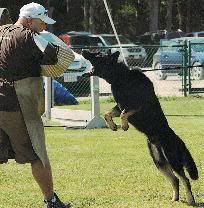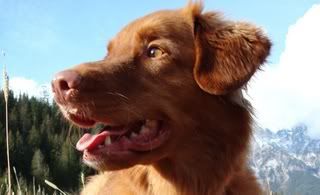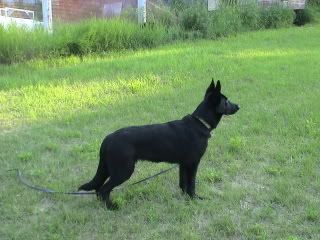 The Pacing Gait
#153909 - 08/30/2007 04:21 PM The Pacing Gait
#153909 - 08/30/2007 04:21 PM |
Webboard User

  
Reg: 07-25-2006
Posts: 2665
Loc: AZ
 Offline Offline |
|
Ok, I've been meaning to ask this for a long time. Lear did this 2 or 3 months ago. When he was coming to me, instead of trotting, he paced! (Pacing is when the animal moves both legs on one side of its body at the same time, like in sulky racing. I think some wild animals pace rather than trot, but can't remember which ones do it.)
Has anyone ever seen their dog do this? It was rather cool to see, but I'm sure my mouth was open with a startled look on my face. He never did it before and hasn't done it since. But he did it twice in that one day.
What the heck? Anybody experienced this before? It looked very primal 
|
 Top Top
|
 Re: The Pacing Gait
[Re: Sandy Moore ]
#153912 - 08/30/2007 04:33 PM Re: The Pacing Gait
[Re: Sandy Moore ]
#153912 - 08/30/2007 04:33 PM |
Webboard User
   
Reg: 04-02-2007
Posts: 749
Loc: Canada
 Offline Offline |
|
In my limited experience dogs will pace somewhere between a walk and a trot? (not sure I have this right) I have heard it can be when the dog is forced into an alkward speed (like between walk and a trot), or when a dog is fatigued, and it can also be a sign of structure issues???
My dog will pace sometimes walking on leash at a speed a hair lower than his trot. Not sure I have seen him do it off leash of his own accord, but we have one dog at work that paces off leash A LOT. (lab chessie X)
Interested to hear what others and breeders think of pacing, I wonder about it too!!! Good question 
|
 Top Top
|
 Re: The Pacing Gait
[Re: Sandy Moore ]
#153913 - 08/30/2007 04:34 PM Re: The Pacing Gait
[Re: Sandy Moore ]
#153913 - 08/30/2007 04:34 PM |
Webboard User
Reg: 05-15-2007
Posts: 46
Loc: Kingston, NH
 Offline Offline |
|
My girl did this twice last night....I thought I had maybe done something when I put her agitation harness on.
She'd never done it before and this morning she was fine.
Not sure why....Maybe she was excited about the work.
Looks funny though.
|
 Top Top
|
Guest1 wrote 08/30/2007 04:38 PM
 Re: The Pacing Gait
[Re: Krystina Gursky ]
#153914 - 08/30/2007 04:38 PM Re: The Pacing Gait
[Re: Krystina Gursky ]
#153914 - 08/30/2007 04:38 PM |
Webboard User
  
Reg: 07-17-2002
Posts: 860
Loc: Iowa
 Offline Offline |
|
Hmm. Can't say I've seen it.
This, right?

|
 Top Top
|
 Re: The Pacing Gait
[Re: Guest1 ]
#153915 - 08/30/2007 04:43 PM Re: The Pacing Gait
[Re: Guest1 ]
#153915 - 08/30/2007 04:43 PM |
Webboard User

  
Reg: 10-18-2006
Posts: 1849
Loc: St. Louis, MO
 Offline Offline |
|
My friend's Gordon Setter does this every time he walks, without exception. I was actually wondering if it was a breed characteristic and forgot to look it up.
He does hit the trot stride when he's moving fast though. Neither of my dogs have ever done it.

Carbon |
 Top Top
|
 Re: The Pacing Gait
[Re: Jennifer Coulter ]
#153918 - 08/30/2007 04:49 PM Re: The Pacing Gait
[Re: Jennifer Coulter ]
#153918 - 08/30/2007 04:49 PM |
Webboard User

   
Reg: 12-22-2006
Posts: 1824
Loc: Cambridge, MA
 Offline Offline |
|
My dog paces a lot - I always thought it was really odd too, as it doesn't seem as smooth or comfortable as a trot - though what Jennifer said about it being a sort of "in between" gait seems to be true with him. Oscar will often go from a walk, to a pace, to a trot, each one getting progressively faster. When off leash, he'll still pace on his own, but when he needs to pick up speed, he shifts into a trot.
Sandy, I think you referenced the really neat Shawlein GSD website at some point - well, they have a GREAT explanation of dog gaits, including detailed information on the pace - here's a quote:
When the dog increases speed, he may briefly pass through a period of "shuffling". This is just a running walk, and is perfectly normal, although most animals built for speed don't do it very much or for very long. It's no different than the running walk of the Icelandic horse, in which it has been genetically selected and intensified. In wild animals, it is typical of really big animals, such as elephant and grizzly, whose mass makes suspension difficult or impossible.
More typically, when increasing speed the dog may shift into a pace, with the legs on the same side moving in synchronization (Fig 3). This is not abnormal, nor is it an indication of structural problems. All dogs pace at one time or another. It's a gait that offers more speed than the walk without the energy consumption of the trot, which is probably why it is seen as a lazy gait. It appears clumsy because the body shifts from side to side, in exactly the same fashion as the camel, nature's best pacer. In fact, what is happening is quite interesting. Normally, a leg, front or rear, must be hauled forward by muscular work, and then thrust forward with more muscular work. But at the pace, the slight shift of the body to one side allows the legs of the opposite side to be swung forward by pendulum action, with very little muscular exertion. The camel uses this gait because of the incredibly harsh nature of its environment and the shortage of resources. It cannot afford to expend a drop more energy than is required. Generally, it is movement without any period of suspension. This would require extra speed and exertion, which the pace is not intended to provide. The Standardbred pacing horse specializes in a highly artificial, high speed, suspended pace because of breeding, training and special harnesses. For the horse, this gait prevents hoof interference and injury, allowing a huge overreach which is more difficult to achieve at the trot. These concerns don't apply to dogs, who use the pace as a more leisurely means of covering ground. For this reason it is not uncommonly seen in tired, aged, sick or unsound animals, and has been construed as an undesirable gait which is necessarily the result of these problems. This is simply not the case.
And a link right to the site:
http://shawlein.com/The_Standard/08_Overview_of_Gait/Overview_of_Gait.html
Hope that helps - I found it pretty interesting!! 
~Natalya
|
 Top Top
|
 Re: The Pacing Gait
[Re: Sandy Moore ]
#153920 - 08/30/2007 04:56 PM Re: The Pacing Gait
[Re: Sandy Moore ]
#153920 - 08/30/2007 04:56 PM |
Webboard User

  
Reg: 03-17-2006
Posts: 4203
Loc:
 Offline Offline |
|
Everything Jennifer said and also sometimes it almost seems like a disinterest in moving where they're actually going. Like holding his head a little down sniffing something. If you ever watch the dog shows you see them either pull up on the lead as they start to move or hang them all the way around the ring. One of the reasons is to keep them from pacing.
|
 Top Top
|
 Re: The Pacing Gait
[Re: Natalya Zahn ]
#153921 - 08/30/2007 04:58 PM Re: The Pacing Gait
[Re: Natalya Zahn ]
#153921 - 08/30/2007 04:58 PM |
Webboard User
   
Reg: 04-02-2007
Posts: 749
Loc: Canada
 Offline Offline |
|
These concerns don't apply to dogs, who use the pace as a more leisurely means of covering ground. For this reason it is not uncommonly seen in tired, aged, sick or unsound animals, and has been construed as an undesirable gait which is necessarily the result of these problems. This is simply not the case.
Well that answers the questions about structural issues, thanks for the link and clip 
|
 Top Top
|
 Re: The Pacing Gait
[Re: Jennifer Coulter ]
#153924 - 08/30/2007 05:07 PM Re: The Pacing Gait
[Re: Jennifer Coulter ]
#153924 - 08/30/2007 05:07 PM |
Webboard User

  
Reg: 03-17-2006
Posts: 4203
Loc:
 Offline Offline |
|
These concerns don't apply to dogs, who use the pace as a more leisurely means of covering ground. For this reason it is not uncommonly seen in tired, aged, sick or unsound animals, and has been construed as an undesirable gait which is necessarily the result of these problems. This is simply not the case.
Well that answers the questions about structural issues, thanks for the link and clip 
I think you were right, sometimes it is structure. I have a video somewhere that talks about it. I just can't remember what the structural fault was.
|
 Top Top
|
 Re: The Pacing Gait
[Re: steve strom ]
#153927 - 08/30/2007 05:27 PM Re: The Pacing Gait
[Re: steve strom ]
#153927 - 08/30/2007 05:27 PM |
Webboard User
  
Reg: 04-17-2002
Posts: 617
Loc:
 Offline Offline |
|
While pacing can be from structure or a fatigue gait - some dogs just pace naturally. I have one sled dog that is a big guy and he can maintain a very fast pace when other dogs in the team are at a lope or a fast trot. Alot of bigger, heavier framed dogs seem to use a pace as a fast-ish gait
|
 Top Top
|
When purchasing any product from Leerburg Enterprises, Inc. it is understood
that any and all products sold by Leerburg Enterprises, Inc. are sold in Dunn
County Wisconsin, USA. Any and all legal action taken against Leerburg Enterprises,
Inc. concerning the purchase or use of these products must take place in Dunn
County, Wisconsin. If customers do not agree with this policy they should not
purchase Leerburg Ent. Inc. products.
Dog Training is never without risk of injury. Do not use any of the products
sold by Leerburg Enterprises, Inc. without consulting a local professional.
The training methods shown in the Leerburg Ent. Inc. DVD’s are meant
to be used with a local instructor or trainer. Leerburg Enterprises, Inc. cannot
be held responsible for accidents or injuries to humans and/or animals.
Copyright 2010 Leerburg® Enterprises, Inc. All rights reserved. All photos and content on leerburg.com are part of a registered copyright owned by Leerburg Enterprise, Inc.
By accessing any information within Leerburg.com, you agree to abide by the
Leerburg.com Privacy Policy and Terms of Use.
 Previous Topic
Previous Topic Index
Index Next Topic
Next Topic














 Top
Top






.jpg)
